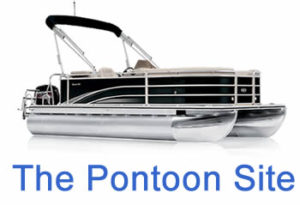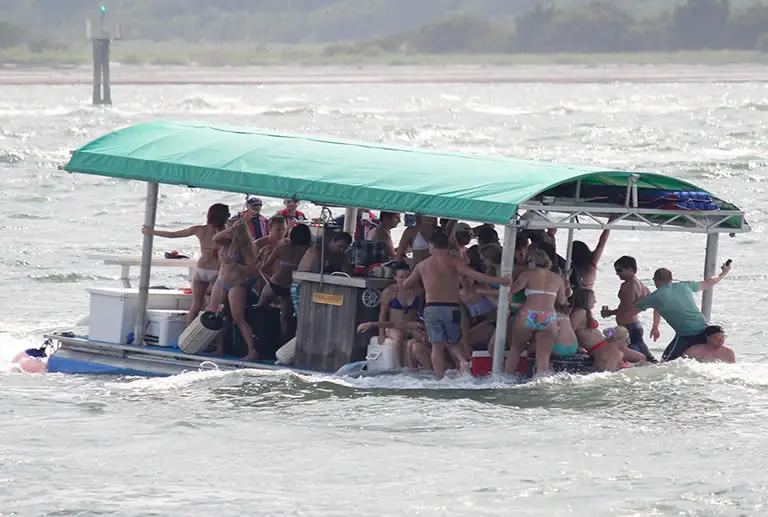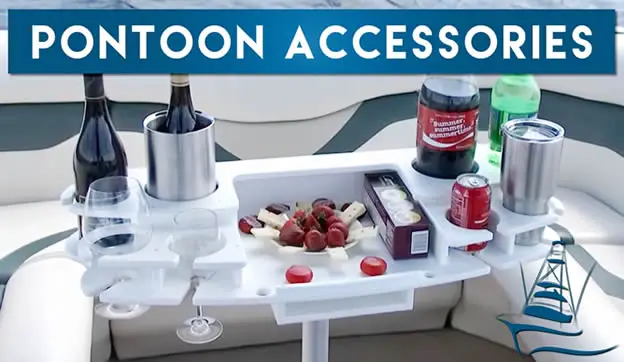Pontoon boats are fun recreational vessels that are usually very stable on calm water but sometimes the disadvantages of owning a pontoon boat become all too real. If you have ever been in the situation where a pontoon you were on nosedived and started to sink, or seen one doing it, then it can be quite scary.
If you want to avoid your pontoon boat from nosediving and sinking then you need to know why this type of boat has a tendency to nosedive in the first place.
Contents
- Why pontoon boats sink
- 9 reasons your pontoon boat took a nosedive
- The boat is front-heavy
- Bad weight distribution of passengers caused an imbalance of weight
- Exceeding weight limits can sink a pontoon boat
- Not enough power can lead to water plowing
- Too much power can force the bow to porpoise
- Trying to ride the waves will cause a pontoon boat to sink
- Wake of large boats can cause pontoon boat instability
- Water in the pontoon tubes will sink a pontoon boat
- One easy modification to avoid nosediving a pontoon boat
- 9 reasons your pontoon boat took a nosedive
Why pontoon boats sink
A pontoon boat can nose dive for multiple reasons.
The most common reason for a pontoon boat sinking is due to nose diving. This usually occurs when there is too much weight at the front of the boat.
However, exceeding weight limits, bad distribution of weight, fitting the wrong motors, having water in the tubes, taking waves and wake too fast and using the boat in very challenging conditions can all cause a pontoon boat to nose dive and sink.
9 reasons your pontoon boat took a nosedive
Below are 9 of the most common reasons a pontoon boat will nose dive into the water.
You may find that you have one or more of the following issues on your boat, so read through the sections carefully and take the appropriate action to combat the situation.
The boat is front-heavy
The most common reason for a nose diving pontoon boat is too much weight at the front of the boat. A pontoon boat should be lighter at the front than the back so that the bow can lift out of the water slightly during acceleration.
When a pontoon boat is heavy at the front it will sit low in the water at the front and tend to lurch forward during acceleration and thus be more prone to dipping below the surface.
To avoid your pontoon being too front heavy be sure that you do not have heavy items at the front of the boat such as furniture and storage units with heavy items in them. These should always be placed nearer the back but evenly distributed.
The water line at your pontoon tubes will help you determine if your pontoon boat is front heavy. The water line at the front of the boat should also be slightly lower than the water line at the rear of the boat.
When the water line at the bow is lower than the water line at the stern it is an indication that your boat is lighter at the front (as it is sitting higher in the water) and thus will be less likely to nose dive.
If you find that your pontoon tubes are equally deep in the water at the front and back you should try redistributing the onboard weight. To make the front of the boater lighter store things like extra fuel and heavier equipment at the back of the boat. If need be move furniture, the jacuzzi and other heavy items further back.
Bad weight distribution of passengers caused an imbalance of weight
Bad weight distribution of passengers on your pontoon boat is basically the same problem as being front heavy but it is worth mentioned because pontoon boat users tend to think of weight distribution more in terms of gear and equipment than people. They forget that poor distribution of passenger weight can also cause instability issues, especially when they are partying.
During pontoon get-togethers, whether they be full-blown beer-guzzling parties or simple family barbecues, passengers can tend to congregate in just one or two spots.
If your boat is well below its weight limit and the weather and water conditions are calm this will not cause much of a problem. But, when you are reaching the the limits of your boat’s weight capacity or encounter choppy water being close to the weight limit or over it it can become a very definite problem.
Make sure your passengers are aware that bunching up into large groups in one area of a pontoon boat is a bad idea. They should be made aware that it’s a good idea to stay well separated, within reason of course.
Exceeding weight limits can sink a pontoon boat
Another common cause behind a pontoon nosedive is exceeding the manufacturer’s weight limit for your boat. Pontoon boat accessories are all well and good but if you have too many onboard along with too many passengers, gear, food and beverages, things can get overcrowded and potentially dangerous very quickly.
Pontoon boats are big and the large deck can lead many people to believe they can load more weight on their boat than is safe. As a pontoon sits very stable while at rest this problem can be exacerbated because the extra weight does not seem to affect stability – that is until you move the boat!
Overloading a pontoon boat is a very bad idea so be sure to stay well within the weight capacity of your pontoon boat.
It is all too easy to overload your vessel, especially if you are having a pontoon boat party with lots of passengers, beverages and food onboard.
If you cannot access the weight capacity information for your specific pontoon boat then a simple check of the water line against your boat’s pontoons will help. The tubes should not be too deep in the water.
The water line should be fairly low on the pontoons. If it is higher than the middle of the pontoons your boat is much too heavy and you need to reduce onboard weight.
Not enough power can lead to water plowing
If your pontoon boat is hanging lower HP motors than it needs you may not have enough power to lift the bow up sufficiently enough to avoid it plowing through the water.
If the boat is loaded with gear and passengers then trying to increase speed will merely make the plowing effect worse and can eventually cause the boat to nose dive.
Make sure you have powerful enough outboard motors for your specific pontoon boat.
Too much power can force the bow to porpoise
Too much power can be just as bad as too little.
Pontoon boats can handle pretty powerful outboard motors but if you give them too much power the thrust can force the bow so far up that it crashes down into the water nose first – a manuever known as porpoising.
Be sure your pontoon boat has the recommended HP engines mounted on it. Never exceed the maximum HP – it is listed as maximum for a reason.
Trying to ride the waves will cause a pontoon boat to sink
Pontoon boats are easy to drive and can handle a certain amount of chop but you must bear in mind that these recreational boats are not built for rough water use (see our guide to using pontoons in rough water).
If the water is choppy you must reduce the speed of a pontoon boat. A pontoon boat is basically a big flat raft sitting on top of two (or three) flotation tubes. It is not equipped to deal with waves.
If you try to speed through very choppy water your pontoon will almost certainly nose dive and almost definitely sink. A similar problem exists with the wake of other boats.
Wake of large boats can cause pontoon boat instability
The wake of powerful or very large boats is often very unfriendly to a pontoon boat. You must handle wakes the same way you handle natural waves.
When you encounter a wake or wave on a pontoon boat you must slow down. With reduced speed take the wave or wake at as close to a 45 degree angle as you can and then work the throttle so that you can keep the bow up on the initial, and any subsequent, waves.
Remember in choppy water speed is not your friend on a pontoon boat.
Water in the pontoon tubes will sink a pontoon boat
Water can get into the tubes on a pontoon boat making the boat much less buoyant and causing it to sit lower in the water than it normally would.
You should make a regular habit of checking that your pontoon tubes have not taken on water. This is as simple as opening the drain plugs to allow any water inside to drain out.
However, you may encounter a problem if the pontoons on your boat are sectioned/chambered.
If the pontoon tubes are sectioned then they will be divided up into different chambers with each pontoon tube having two or even three chambers that are separated from each other.
One or more chambers could have water in it while the others do not.
If there are are drain holes between the chambers, great. You can drain each chamber.
If there are no such drain holes and some of the chambers are filled with water then you could have a problem.
Keep in mind that just because no water drains out from the rear of the pontoon tube that doesn’t mean that there isn’t any water in the front or middle.
If you have exhausted all other options and feel that water in a chambered tube is the only possible cause for your pontoon’s instability issues call the manufacturer of your boat.
Give them the HIN (Hull ID Number) and ask if the pontoon tubes on your boat are chambered or not. Then ask them what you can do to empty the tubes if there’s water in them.
One easy modification to avoid nosediving a pontoon boat
Back in the 1980s Sun tracker had a problem when some of their 24 foot pontoon boats started developing a tendency to nose dive.
To fix the problem they sent all their customers a small “pony toon” to attach to the middle of their boat, essentially turning the pontoon boat into a tritoon boat (see pontoon vs tritoon).
This pony toon was a small 10 foot pontoon that bolted under the middle of the boat to help stop the nose dive effect.
It was a very effective solution to the problem and is something you should consider doing to your own boat if you are worried about your pontoon taking a nose dive in the future.



